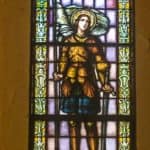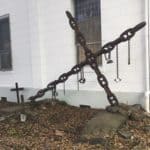Will the First African American Saint Come from New Orleans?
During a recent trip to New Orleans, I was startled to learn there are no African American saints. Linda Harris was showing me around Saint Augustine Church when the matter came up.
“Really?” I ask Harris. “No African American saints?”
Not yet. While there are at least a dozen black saints, including the Peruvian Saint Martin de Porres and the Egyptian Saint Moses the Black, no African Americans have been canonized.
Saint Augustine Church is in New Orleans’ Treme neighborhood, just outside the French Quarter and about ten blocks from the river, on the corner of Henriette DeLille Street. The street is named for the woman many New Orleanians hope will be the first African American saint. “We do believe and pray,” she says. “We hope that will happen real soon.”
DeLille was born a free person of color in New Orleans in 1813. In 1842, she founded the Sisters of the Congregation of the Holy Family, the country’s second order of African American nuns (The Oblates were the first). DeLille ministered to free people of color and to slaves, earning the nickname “Servant of Slaves.” Pope Benedict XVI declared her venerable in 2010. Now she’s two confirmed miracles away from full-fledged sainthood.
“The Sisters of Holy Family are a strong presence,” Harris, the church secretary of Saint Augustine’s, tells me as we gaze at a portrait of DeLille. Their mother house is in New Orleans East. The sisters manage schools and nursing homes in New Orleans, other parts of the country and even as far away as Belize.
The Importance of Saint Augustine Church
Henriette DeLille had close ties with Saint Augustine Church. In fact, when she died in 1862, her funeral was held here.
The Treme was originally a plantation. When the land was divided in 1790, free people of color bought most of the lots. “This Treme neighborhood that we’re in is one of the oldest communities that allowed African Americans to purchase property,” says Harris, who’s a Treme native. “It’s considered by many the oldest African American neighborhood in the country.”
The church was built in 1841, established by free people of color. The Ursuline nuns donated money for the church grounds. When I visited in December 2016, banners celebrating the church’s 175thbirthday hung above the altar.
The French influence of early New Orleans is apparent, from the John 4:10 quotation painted in French above the altar, to the stained glass windows depicting French saints. “We have a particular fondness for Saint Joan of Arc,” Harris tells me. As patron saint of New Orleans, Joan is popular throughout the city.
Two of the beautifully painted Stations of the Cross are missing. During Hurricane Katrina, they were out for repairs in an area that got eight to 12 feet of water. “So they’ll never be seen again,” Harris says.
The Saint Augustine community is proud to be honored by the new National Museum of African American History and Culture at the Smithsonian. The museum has several pieces from the church in its collection, including a votive candle holder and a kneeler.
War of the Pews
One of the famous stories about Saint Augustine Church is the “war of the pews.” While the church was being constructed, Harris tells me, “People were buying pews so they could sit with their own family on a pew and sort of be guaranteed it every Sunday.” Whites and free people of color tried to buy up the best pew real estate. “So it was a war of the pews,” Harris says. For once in New Orleans, the free people of color won. “They bought slightly more than the whites,” she says. “The free people of color bought pews for the slaves as well. So in that light, it was sort of a place of integration, way back then.”
Tomb of the Unknown Slave
Outside the church is one of the most moving monuments I’ve ever seen. The Tomb of the Unknown Slave, dedicated in 2004, is made of grave crosses, chains and shackles. As it says on the accompanying plaque, the monument is dedicated “to the memory of the nameless, faceless, turfless Africans who met an untimely death in Faubourg Treme.”
“It’s a very powerful piece,” Harris says. The slaves that died on the former Treme plantation are very real to her, not just part of long ago history. “Historically, while they may not all have felt as cared for in life, they appreciated a decent burial, and a decent burial for family members.” The monument was designed to help soothe those abused, neglected and forgotten souls. “It acknowledges and shares with its significance anyone who perished due to mistreatment, no health insurance, those type things. So it’s shared with all who passed away and had no real burial place.”
Integrated into the City
Church membership has dwindled a bit since Katrina, with about 340 members currently registered. But the church’s historical importance and its connections to the French Quarter Festival organization, the Jazz and Heritage Office and the New Orleans Marketing and Tourism Commission spread its reputation beyond regular attendees. “They support us,” Harris says. “And they appreciate the fact that while we are a Catholic church, we embrace the music and culture of New Orleans.”
The French Quarter Festival sponsors the Satchmo Summer Mass here in conjunction with the Satchmo Summer Festival in August, celebrating Louis Satchmo Armstrong. Armstrong, who lived in the neighborhood, had ties to the church. Saint Augustine also participates in the citywide Christmas New Orleans Style events, with three concerts in December of 2016.
The church draws tourists – black, white, some from as far away as Asia. Thanks to social media, Harris says, word about her church’s significance reaches around the globe. The gospel choir is also a big draw. “We have a very spirited service, while it is a Roman Catholic mass,” she says. “And it’s nice to have tourists in town and also have a place of worship they can come, as well as just partying and drinking and what have you.”
Tourists come and go, but New Orleanians continue to attend every week. Sometimes members of DeLille’s order, the Sisters of the Holy Family, attend mass and other church functions. “They’re an aging order like most religious orders, male and female,” Harris says, admiring the nuns that are still carrying on DeLille’s legacy. “Sometimes they walk in on crutches. But they get more done in a day than you or I.”
As an inner city church, and an old church, Saint Augustine struggles with repairs and maintenance. “But we love our old parish,” Harris says. “We love our old church.”



